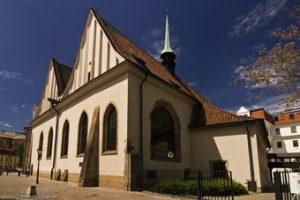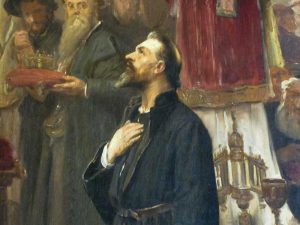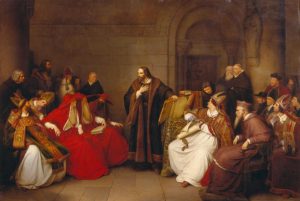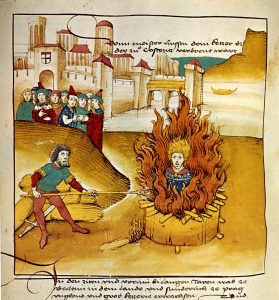Jan Hus (c. 1369 – 6 July 1415), often referred to in English as John Hus or John Huss, was a Czech priest, philosopher, early Christian reformer and Master at Charles University in Prague. After John Wycliffe, the theorist of ecclesiastical Reformation, Hus is considered the first Church reformer, as he lived before Luther, Calvin and Zwingli.
Hus was a key predecessor to the Protestant movement of the sixteenth century, and his teachings had a strong influence on the states of Western Europe, most immediately in the approval of a reformist Bohemian religious denomination, and, more than a century later, on Martin Luther himself. He was burned at the stake for heresy against the doctrines of the Catholic Church, including those on ecclesiology, the Eucharist, and other theological topics.
After his execution in 1415, the followers of Hus’s religious teachings (known as Hussites) rebelled against their Roman Catholic rulers and defeated five consecutive papal crusades between 1420 and 1431 in what became known as the Hussite Wars. A century later, as many as 90% of inhabitants of the Czech lands were non-Catholic and some still followed the teachings of Hus and his successors.
Early life
Jan Hus was born in Husinec, Bohemia, around 1369. At an early age he traveled to Prague, where he supported himself by singing and serving in Churches. His conduct was positive and his commitment to his studies was remarkable. In 1393, Hus earned the degree of Bachelor of Arts at the University of Prague, and he earned his master’s degree in 1396. In 1400, he was ordained as a priest. In 1402 Hus began preaching inside the city demanding for the reformation of the Church. He served as rector of the University of Prague in 1402–03. He was appointed a preacher at the newly built Bethlehem Chapel around the same time. Hus was a strong advocate for the Czechs, and therefore the Realists, and he was influenced by the writings of John Wycliffe. Although Church authorities banned many works of Wycliffe in 1403, Hus translated Trialogus into Czech and helped to distribute it.
Career
Hus tried to reform the Church by delineating the moral failings of clergy, bishops, and even the papacy from his pulpit. Archbishop Zbyn?k Zajíc tolerated this, and even appointed Hus as preacher to the clergy’s biennial synod. On 24 June 1405, Pope Innocent VII, however, directed the Archbishop to counter Wycliffe’s teachings, especially the doctrine of impanation in the Eucharist. The archbishop complied by issuing a synodal decree against Wycliffe, as well as forbidding any further attacks on the clergy.
In 1406, two Bohemian students brought to Prague a document bearing the seal of the University of Oxford and praising Wycliffe. Hus proudly read the document from his pulpit. Then in 1408, Pope Gregory XII warned Archbishop Zajic that the Church in Rome had been informed of Wycliffe’s heresies and of King Wenceslaus’s sympathies for non-conformists. In response, the king and University ordered all of Wycliffe’s writings surrendered to the archdiocesan chancery for correction. Hus obeyed, declaring that he condemned the errors in those writings.
Papal Schism
At this time (1408), the Charles University in Prague was divided by the Western Schism, in which Gregory XII in Rome and Benedict XIII in Avignon both claimed the papacy. Wenceslaus felt Gregory XII might interfere with his plans to be crowned Holy Roman Emperor. He denounced Gregory, ordered the clergy in Bohemia to observe a strict neutrality in the schism, and said that he expected the same of the University. Archbishop Zajíc remained faithful to Gregory. At the University, only the scholars of the Bohemian “nation” (one of the four governing sections), with Hus as their leader, vowed neutrality.
Kutná Hora Decree
At the urging of Hus and other Bohemian leaders, King Wenceslaus decreed (in Kutná Hora) that the “Bohemian nation” would have three votes (instead of one) in University affairs, while the Bavarian, Saxon, and Polish “nations” would have only one vote in total. As a consequence, between five thousand and twenty thousand foreign doctors, masters, and students left Prague in 1409. This exodus resulted in the founding of the University of Leipzig, among others. Thus Charles University lost its international importance and became a strictly Czech school. The emigrants also spread news of the Bohemian “heresies” throughout the rest of Europe. Archbishop Zajíc became isolated and Hus was at the height of his fame. He became Rector of the University, and enjoyed the favor of the court. Wycliffe’s doctrines also regained favor in Prague.
Alexander V becomes Antipope
In 1409, the Council of Pisa tried to end the schism by electing Alexander V as Pope, but Gregory and Benedict did not submit. (Alexander was declared an “antipope” by the Council of Constance in 1418.)
Hus, his followers, and Wenceslaus transferred their allegiance to Alexander V. Under pressure from Wenceslaus, Archbishop Zajíc did the same. Zajíc then lodged an accusation of “ecclesiastical disturbances” against Wycliffites in Prague with Alexander V.
Excommunication
On 20 December 1409, Alexander V issued a papal bull that empowered the Archbishop to proceed against Wycliffism in Prague. All copies of Wycliffe’s writings were to be surrendered and his doctrines repudiated, and free preaching discontinued. After the publication of the bull in 1410, Hus appealed to Alexander V, but in vain. The Wycliffe books and valuable manuscripts were burned, and Hus and his adherents were excommunicated by Alexander V.
Indulgences
Indulgences were closely tied with the Roman Catholic doctrine of Purgatory. All souls other than saints would go to Purgatory for a time of purgation, suffering and punishment to purify them for their sins before they could enter Heaven. A Papal Indulgence was a document which excused the person from a certain period of purgation. These would be sold to raise money for crusades by travelling salesmen, with a portion of the proceeds often going to local nobles.
After Archbishop Zajíc died in 1411, and with his death the religious movement in Bohemia entered a new phase, where the disputes concerning indulgences assumed great importance.
Crusade against Naples
Alexander V died in 1410, and was succeeded by John XXIII (also later declared an antipope). In 1411, John XXIII proclaimed a crusade against King Ladislaus of Naples, the protector of rival Pope Gregory XII. This crusade was preached in Prague as well. John XXIII also authorized the sale of indulgences to raise money for the war, and priests selling indulgences urged people to crowd the churches and give their offerings. This traffic in indulgences was to some a sign of the corruption of the church.
Condemnation of indulgences and Crusade
Hus spoke out against indulgences, but he could not carry with him the men of the university. In 1412, a dispute took place, on which occasion Hus delivered his address Quaestio magistri Johannis Hus de indulgentiis. It was taken literally from the last chapter of Wycliffe’s book, De ecclesia, and his treatise, De absolutione a pena et culpa. Hus asserted that no Pope or bishop had the right to take up the sword in the name of the Church; he should pray for his enemies and bless those that curse him; man obtains forgiveness of sins by true repentance, not money. The doctors of the theological faculty replied, but without success. A few days afterward, some of Hus’s followers, led by Vok Voksa z Valdštejna, burnt the Papal bulls. Hus, they said, should be obeyed rather than the Church, which they considered a fraudulent mob of adulterers and Simonists.
In response, three men from the lower classes who openly called the indulgences a fraud were beheaded. They were later considered the first martyrs of the Hussite Church. In the meantime, the faculty had condemned the forty-five articles and added several other theses, deemed heretical, which had originated with Hus. The king forbade the teaching of these articles, but neither Hus nor the university complied with the ruling, requesting that the articles should be first proven to be un-scriptural. The tumults at Prague had stirred up a sensation; papal legates and Archbishop Albik tried to persuade Hus to give up his opposition to the papal bulls, and the king made an unsuccessful attempt to reconcile the two parties.
Attempts at reconciliation
Wenceslaus made efforts to harmonize the opposing parties. In 1412, he convoked the heads of his kingdom for a consultation and, at their suggestion, ordered a synod to be held at ?eský Brod on 2 February 1412. It did not take place there, but in the palace of the archbishops at Prague, in order to exclude Hus from participation. Propositions were made to restore peace in the Church. Hus declared that Bohemia should have the same freedom in regard to ecclesiastical affairs as other countries and that approbation and condemnation should therefore be announced only with the permission of the state power. This was the doctrine of Wycliffe (Sermones, iii. 519, etc.).
There followed treatises from both parties, but no harmony was obtained. “Even if I should stand before the stake which has been prepared for me,” Hus wrote at the time, “I would never accept the recommendation of the theological faculty.” The synod did not produce any results, but the King ordered a commission to continue the work of reconciliation. The doctors of the university demanded approval of their conception of the Church, according to which the Pope is the head, the Cardinals are the body of the Church, from Hus and his followers. Hus protested vigorously. The Hussite party seems to have made a great effort toward reconciliation. To the article that the Roman Church must be obeyed, they added only “so far as every pious Christian is bound”. Stanislav ze Znojma and Št?pán Pále? protested against this addition and left the convention; they were exiled by the king, with two others.
Hus leaves Prague and appeals to Jesus Christ
By this time, Hus’s ideas had become widely accepted in Bohemia, and there was broad resentment against the Church hierarchy. The attack on Hus by the Pope and Archbishop caused riots in parts of Bohemia. Wenceslaus and his government took the side of Hus, and the power of his adherents increased from day to day. Hus continued to preach in the Bethlehem Chapel. The churches of the city were put under the ban, and the interdict was pronounced against Prague. To protect the city, Hus left and went into the countryside, where he continued to preach and write.
Before Hus left Prague, he decided to take a step which gave a new dimension to his endeavors. He no longer put his trust in an indecisive King, a hostile Pope or an ineffective Council. On 18 October 1412 he appealed to Jesus Christ as the supreme judge. By appealing directly to the highest Christian authority, Christ himself, he bypassed the laws and structures of the medieval Church. For the Bohemian Reformation, this step was as significant as the 95 thesis nailed to the door of the Wittenberg church by Martin Luther in 1517.
After Hus left Prague for the country, he realized what a gulf there was between university education and theological speculation on one hand, and the life of uneducated country priests and the laymen entrusted to their care on the other. Therefore he started to write many texts in Czech, such as basics of the Christian faith or preachings, intended mainly for the priests whose knowledge of Latin was poor.
Writings of Hus and Wycliffe
Of the writings occasioned by these controversies, those of Hus on the Church, entitled De Ecclesia, were written in 1413 and have been most frequently quoted and admired or criticized, and yet their first ten chapters are but an epitome of Wycliffe’s work of the same title, and the following chapters are but an abstract of another of Wycliffe’s works (De potentate papae) on the power of the Pope. Wycliffe had written his book to oppose the common position that the Church consisted only of the clergy, and Hus now found himself making the same point. He wrote his work at the castle of one of his protectors in Kozí Hrádek, and sent it to Prague, where it was publicly read in the Bethlehem Chapel. It was answered by ze Znojma and Pále? with treatises of the same title.
After the most vehement opponents of Hus had left Prague, his adherents occupied the whole ground. Hus wrote his treatises and preached in the neighborhood of Kozí Hrádek. Bohemian Wycliffism was carried into Poland, Hungary, Croatia, and Austria. But in January 1413, a general council in Rome condemned the writings of Wycliffe and ordered them to be burned.
Council of Constance
Wenceslaus’ brother Sigismund of Hungary, who was “King of the Romans” (that is, head of the Holy Roman Empire, though not then Emperor), and heir to the Bohemian crown, was anxious to put an end to religious dissension within the Church. To put an end to the papal schism and to take up the long desired reform of the Church, he arranged for a general council to convene on 1 November 1414, at Konstanz (Constance). The Council of Constance (1414–1418) became the 16th ecumenical council recognized by the Catholic Church. Hus, willing to make an end of all dissensions, agreed to go to Constance, under Sigismund’s promise of safe conduct.
Jan Hus at the Council of Constance
It is unknown whether Hus knew what his fate would be, but he made his will before setting out. He started on his journey on 11 October 1414; on 3 November 1414, he arrived at Constance, and on the following day, the bulletins on the church doors announced that Michal z N?meckého Brodu would be opposing Hus. In the beginning, Hus was at liberty, under his safe-conduct from Sigismund, and lived at the house of a widow. But he continued celebrating Mass and preaching to the people, in violation of restrictions decreed by the Church. After a few weeks, his opponents succeeded in imprisoning him, on the strength of a rumor that he intended to flee. He was first brought into the residence of a canon and then, on 8 December 1414, into the dungeon of the Dominican monastery. Sigismund was greatly angered, as the guarantor of Hus’s safety, and threatened the prelates with dismissal; however, the prelates convinced him that he could not be bound by promises to a heretic.
On 4 December 1414, John XXIII entrusted a committee of three bishops with a preliminary investigation against Hus. As was common practice, witnesses for the prosecution were heard, but Hus was not allowed an advocate for his defense. His situation became worse after the downfall of John XXIII, who had left Constance to avoid abdicating. Hus had been the captive of John XXIII and in constant communication with his friends, but now he was delivered to the Archbishop of Constance and brought to his castle, Gottlieben on the Rhine. Here he remained for 73 days, separated from his friends, chained day and night, poorly fed, and ill.
Trial
On 5 June 1415, he was tried for the first time, and for that purpose was transferred to a Franciscan monastery, where he spent the last weeks of his life. Extracts from his works were read, and witnesses were heard. He refused all formulae of submission, but declared himself willing to recant if his errors should be proven to him from the Bible. Hus conceded his veneration of Wycliffe, and said that he could only wish his soul might some time attain unto that place where Wycliffe’s was. On the other hand, he denied having defended Wycliffe’s doctrine of The Lord’s Supper or the forty-five articles; he had only opposed their summary condemnation. King Wenceslaus admonished him to deliver himself up to the mercy of the Council, as he did not desire to protect a heretic.
At the last trial, on 8 June 1415, thirty-nine sentences were read to him, twenty-six of which had been excerpted from his book on the Church, seven from his treatise against Pále?, and six from that against Stanislav ze Znojma. The danger of some of these doctrines to worldly power was explained to Sigismund to incite him against Hus. Hus again declared himself willing to submit if he could be convinced of errors. This declaration was considered an unconditional surrender, and he was asked to confess:
- that he had erred in the theses which he had hitherto maintained;
- that he renounced them for the future;
- that he recanted them; and
- that he declared the opposite of these sentences.
He asked to be exempted from recanting doctrines which he had never taught; others, which the assembly considered erroneous, he was not willing to revoke; to act differently would be against his conscience. These words found no favorable reception. After the trial on 8 June, several other attempts were purportedly made to induce him to recant, which he resisted.
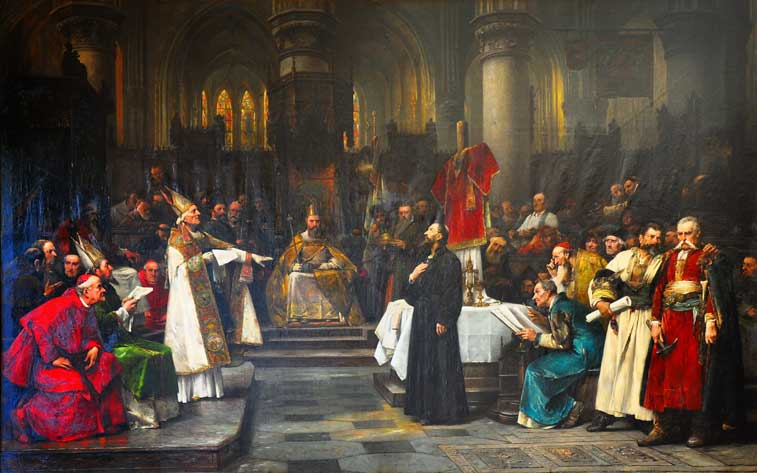
Jan Hus is condemned at the Council of Constance. Painting by Vaclav_Brozik, (1883)
Condemnation
The condemnation took place on 6 July 1415, in the presence of the assembly of the Council in the Cathedral. After the High Mass and Liturgy, Hus was led into the church. The Bishop of Lodi delivered an oration on the duty of eradicating heresy; then some theses of Hus and Wycliffe and a report of his trial were read.
Refusals to recant
An Italian prelate pronounced the sentence of condemnation upon Hus and his writings. Hus protested, saying that even at this hour he did not wish anything, but to be convinced from Scripture. He fell upon his knees and asked God with a low voice to forgive all his enemies. Then followed his degradation — he was dressed in priestly vestments and again asked to recant; again he refused. With curses, Hus’ ornaments were taken from him, his priestly tonsure was destroyed, and the sentence of the Church was pronounced, stripping him of all rights, and he was delivered to secular authorities. Then a tall paper hat was put upon his head, with the inscription “Haeresiarcha” (i.e. the leader of a heretical movement). Hus was led away to the stake under a strong guard of armed men.
Execution
At the place of execution, he knelt down, spread out his hands, and prayed aloud. The executioner undressed Hus and tied his hands behind his back with ropes, and bound his neck with a chain to a stake around which wood and straw had been piled up so that it covered him to the neck. At the last moment, the imperial marshal, von Pappenheim, in the presence of the Count Palatine, asked Hus to recant and thus save his own life. Hus declined thus:
God is my witness that the things charged against me I never preached. In the same truth of the Gospel which I have written, taught, and preached, drawing upon the sayings and positions of the holy doctors, I am ready to die today.
It is said that when he was about to expire, he cried out, “Christ, son of the Living God, have mercy on us!” Hus’ ashes were collected, the very ground under the stake dug up, and thrown into the Rhine River to prevent his disciples from claiming or preserving any relics.


